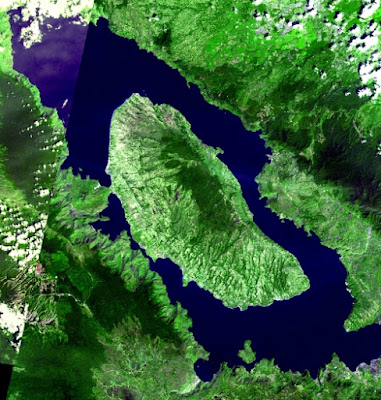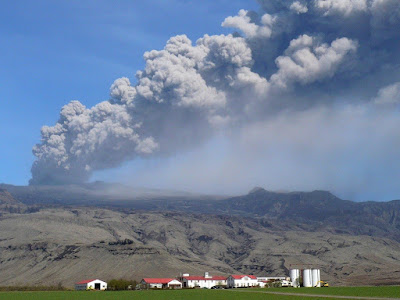 |
| Toba supervolcano – image credit NASA METI AIST Japan Space Systems, and U.S. Japan ASTER Science Team |
I’m sat in my office in the Earth Sciences department reading a research paper entitled ‘The global magnitude-frequency relationship for large explosive volcanic eruptions’. Two lines in and I can already picture the headlines: ‘APOCOLYPTIC VOLCANIC ERUPTION DUE ANY DAY’ or perhaps ‘MANAGED TO GET OFF BALI? YOU’RE STILL NOT SAFE FROM THE VOLCANOES. The temptation is to laugh but I suppose it’s not actually very funny.
The paper in question, produced by four Bristol scientists and published in Earth and Planetary Science Letters on Wednesday, uses a database of recorded volcanic eruptions to make estimates about the timing of large world-changing eruptions. It is the first estimate of its kind to use such a comprehensive database and the results are a little surprising.
In case you’re in a rush, the key take-home message is this…
When it comes to rare volcanic eruptions, the past is the key to the future. Volcanoes have erupted in the past. A lot. These past eruptions establish a pattern, which, assuming nothing has changed, can give us clues about the future. This can be done for a range of eruption sizes, but this paper focusses on the biggest of the lot. It turns out they have happened more frequently than previously thought. Yes, it’s surprising. No, you don’t need to worry.
Here’s how they did it:
In reality, supplying the kind of information needed for a study like this is an enormous task. Generations of volcanologists have found evidence of volcanic material from thousands of past eruptions scattered all over the world. Key bits of information on these eruptions has been collected across many years by hundreds of geologists and collated in one place called the LaMEVE database.
The database essentially turns each volcanic eruption into a statistic based on when it erupted and the eruption size. These statistics are the fuel for the study by statistician Prof Jonty Rougier and three volcanologists (and Cabot Institute members), Prof. Steve Sparks, Prof. Katharine Cashman and Dr Sarah Brown.
The paper highlights that overwhelming majority of these eruptions have been fairly small (think Eyjafjallajökull*, think Stromboli), a smaller proportion have been a bit more lively (heard of Krakatau? Mount St. Helens?) and a really very tiny proportion are so big they might be described as ‘civilisation ending’ if they occurred today. I can’t give a well-known example of one of these as we, fairly obviously, haven’t had one in human timescales.
 |
| Mount St Helens. Credit: Keri McNamara. |
To give you a flavour, here are some statistics from the Toba super-eruption that occurred about 75 thousand years ago. The eruption produced a minimum of 2800km3 of material.. That is equivalent to covering the entire area of the UK in a 12-meter-thick layer of volcanic material, or filling the O2 arena a million times. It is thought the corresponding ash and aerosols that circled the earth cooled the surface temperature by between 3 and 10oC. The reduction in the sun’s radiation would see the death of the majority of plant species, and consequently human’s primary food source.
It paints a rather grim picture. The alarming part of the new study is that eruptions such as Toba might not be as rare as previously thought. Earlier reports have suggested that these eruptions occur every 45-714 thousand years. The new paper revises this range down to 5.2 -48 thousand years with a best guess of one every 17 thousand years. According to geological records, the most recent super eruptions were between 20 and 30 thousand years ago (Taupo 25 ka, Aira 27 ka).
Given that humans started to use agriculture around 12 thousand years ago, it seems as though our modern civilization has flourished in the gap between super eruptions. As Prof.Rougier commented: “on balance, we have been slightly lucky not to experience any super-eruptions in the last 20 thousand years.” A little scary perhaps?
Here’s why you shouldn’t worry:
The really important part of all this is uncertainty.There is a huge amount of statistical leeway either side of these estimates.
Trying to put an exact number on the recurrence interval of something so naturally complex is a bit like trying to estimate the final score of a football match without knowing exactly who the players are. You know how well the team has performed in the past, but you don’t know who will play in the future, or if the same player will behave the same way in every game. There are
also a whole range of things that could happen but probably won’t – perhaps the whole match will get rained off?
Volcanoes aren’t much different. Just because a volcano has exhibited one pattern in the past, doesn’t necessarily mean it will do the same in the future. Volcanic systems are infinitely complicated and affected by a huge range of different variables. Assuming perfect cyclicity in eruption recurrence intervals just isn’t realistic. As Prof. Rougier said ‘It is important to appreciate that the absence of super-eruptions in the last 20 ,000 years does not imply that one is overdue. Nature is not that regular.’
On top of that, our records of volcanic eruptions in the past are far from perfect. Sizes of prehistoric eruptions are easily under or overestimated, and some are simply missing from the record. Generally, the further you go back in time, the hazier it gets. While Rougier and his co-authors have done their best to account for these uncertainties, it is impossible to do so completely.
If that wasn’t enough to put your mind at rest, it is important to remember that geological timescales are a lot bigger than human ones. Whether a volcano erupts every 200 thousand years or 202 thousand years is a very small difference in the context of a volcano’s period of dormancy.
But the extra few thousand years encompasses the last two millennia and the
hundreds of human generations that have lived within it.
When it comes down to it, the real risks from volcanoes come not from the super-eruptions, but from the smaller, frequent, more locally devastating eruptions. Ultimately, when volcanoes like Agung in Bali erupt, it isn’t us who will suffer. It is those who depend on the volcano for their homes and livelihood who will have to uproot and leave. The real value in this research is not in scare mongering, or in a dramatic headline, it’s developing new techniques that further our understanding of these unpredictable natural phenomena.
(*Remember
in 2010 when a volcano in Iceland erupted and shut European airspace?
Eyjafjallajökull: Pronounced ‘eye-ya–fiyat-la-yer–kitle’ in case anyone’s interested)
Read the original press release Time between world-changing volcanic super-eruptions less than previously thought
—————————————–
This blog is written by Keri McNamara: Cabot Institute writer and geologist in the School of Earth Sciences at the University of Bristol. Keri’s current research looks at using ash layers to improve records of volcanism in the central Main Ethiopian Rift.
 |
| Keri McNamara |
To read more about the Cabot Institute’s Research, you can subscribe to this blog, or subscribe to our weekly newsletter













